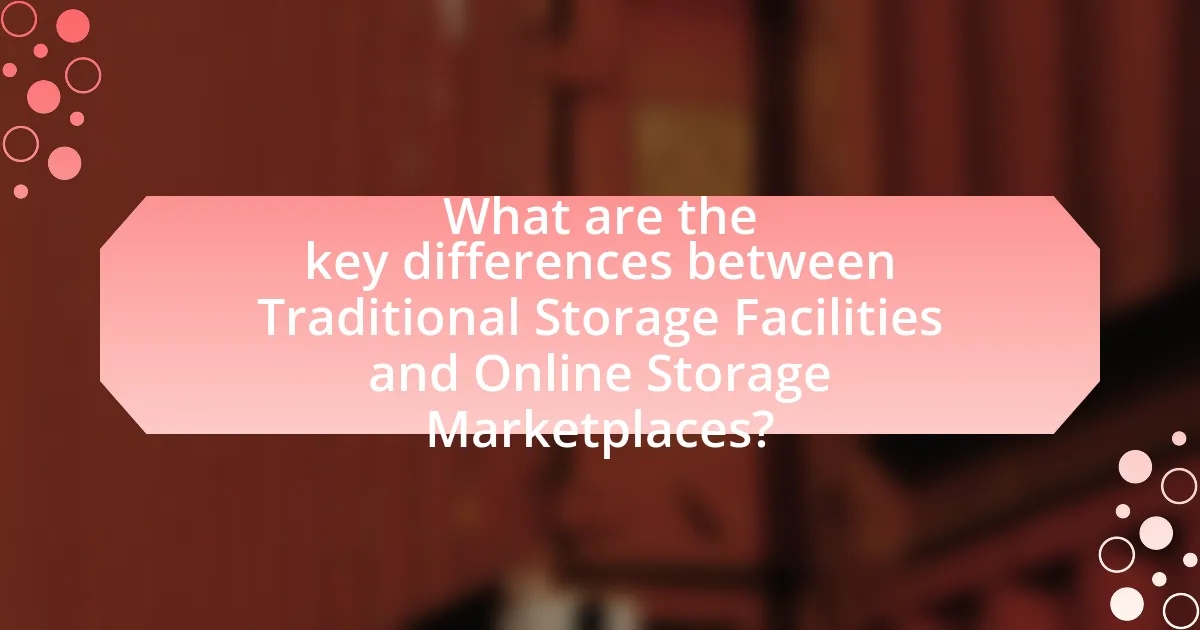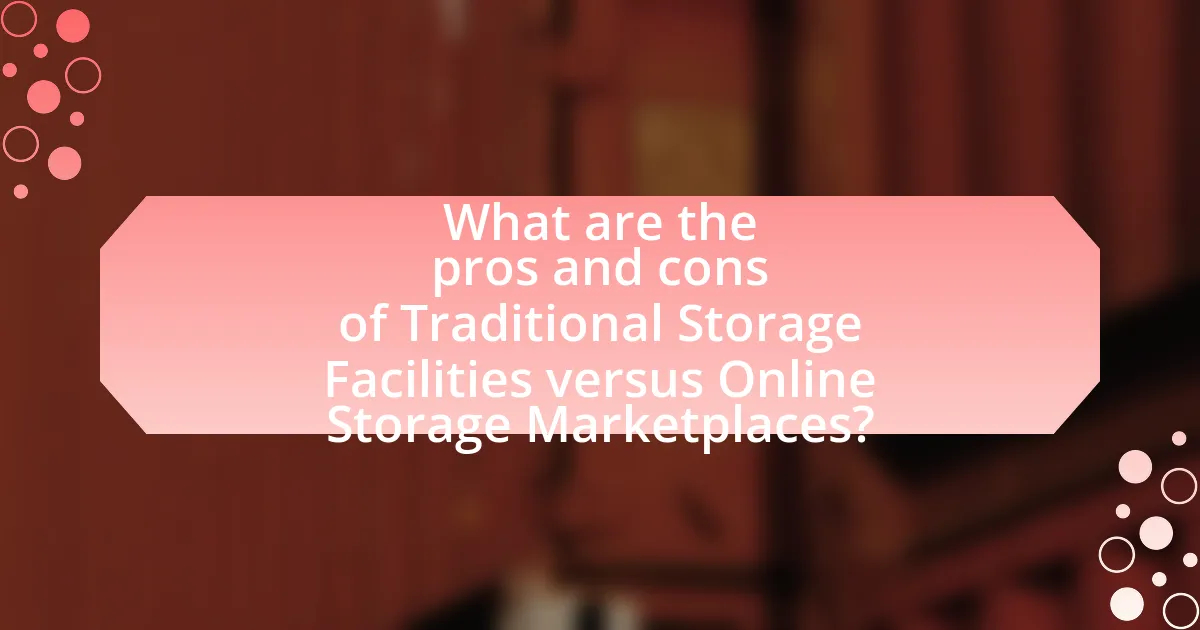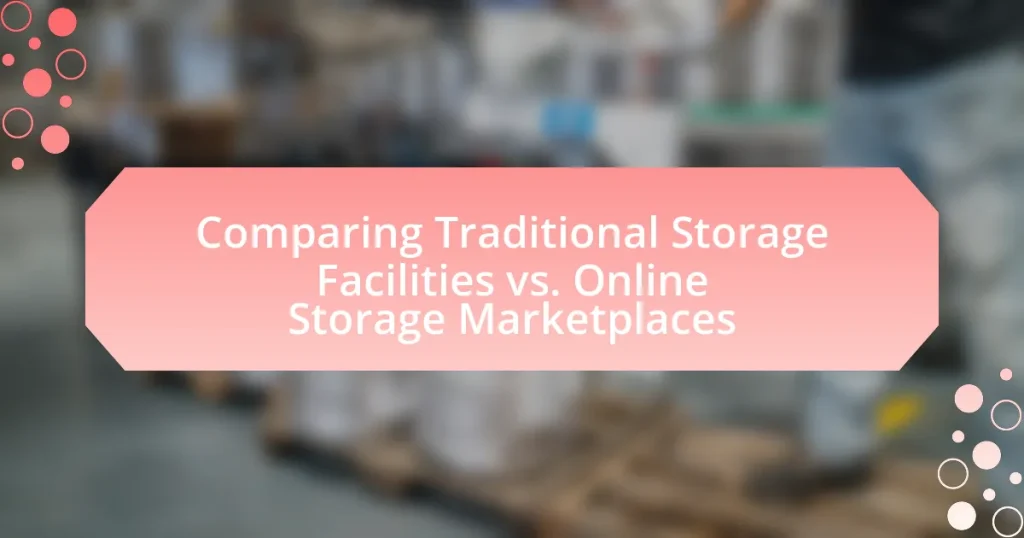The article compares traditional storage facilities and online storage marketplaces, highlighting their distinct characteristics and operational models. Traditional storage facilities provide physical spaces for individuals and businesses to store items, offering various unit sizes, security features, and services such as climate control. In contrast, online storage marketplaces are digital platforms that connect users with available storage options, emphasizing flexibility, cost-effectiveness, and 24/7 access. Key differences include pricing structures, accessibility, security measures, and customer service experiences, allowing consumers to assess their storage needs effectively and make informed decisions based on their specific requirements.
What are Traditional Storage Facilities and Online Storage Marketplaces?

 |
|
Traditional storage facilities are physical locations where individuals or businesses can rent space to store their belongings, such as self-storage units or warehouses. These facilities typically offer various unit sizes and security features, allowing customers to access their stored items at their convenience.
Online storage marketplaces, on the other hand, are digital platforms that connect individuals or businesses looking to store items with available storage spaces offered by other users. These marketplaces facilitate transactions and often provide features like pricing comparisons, user reviews, and booking options, making it easier for customers to find and secure storage solutions.
The distinction between the two lies in the nature of access and convenience; traditional storage facilities require physical visits, while online storage marketplaces leverage technology to streamline the storage process and enhance accessibility.
How do Traditional Storage Facilities operate?
Traditional storage facilities operate by providing physical space for individuals and businesses to store their belongings securely. Customers rent storage units of various sizes, which are typically accessed through a secure entry system. These facilities often offer climate-controlled options to protect sensitive items and may include features such as surveillance cameras and on-site management for added security. According to the Self Storage Association, the self-storage industry has grown significantly, with over 50,000 facilities in the United States alone, indicating a strong demand for traditional storage solutions.
What types of services do Traditional Storage Facilities provide?
Traditional storage facilities provide a range of services including short-term and long-term storage solutions, climate-controlled units, vehicle storage, and packing supplies. These facilities typically offer secure, accessible spaces for individuals and businesses to store their belongings, with options for different unit sizes to accommodate various needs. Additionally, many traditional storage facilities provide 24/7 access, surveillance systems for security, and customer support to assist with inquiries and reservations.
What are the typical costs associated with Traditional Storage Facilities?
The typical costs associated with traditional storage facilities range from $50 to $300 per month, depending on factors such as location, unit size, and facility amenities. For instance, a standard 10×10 storage unit in urban areas may cost around $150 monthly, while rural locations might offer similar units for as low as $50. Additionally, many facilities charge one-time fees for administrative costs, security deposits, and insurance, which can add another $20 to $100 to the initial expenses. These costs reflect the operational expenses of maintaining physical storage spaces, including security, climate control, and property management.
What are Online Storage Marketplaces?
Online storage marketplaces are digital platforms that facilitate the buying, selling, or renting of storage space, typically from individual owners or businesses. These marketplaces connect users who need storage with those who have available space, often offering a variety of options such as self-storage units, garages, or even spare rooms. The rise of online storage marketplaces has been driven by the increasing demand for flexible and cost-effective storage solutions, with platforms like Neighbor and SpareFoot reporting significant growth in user engagement and transactions.
How do Online Storage Marketplaces function?
Online storage marketplaces function by connecting individuals or businesses that need storage space with those who have available storage to rent. These platforms facilitate transactions by allowing users to list their storage spaces, set prices, and manage bookings through an online interface.
Users seeking storage can search for available options based on location, size, and price, while storage providers can showcase their offerings with descriptions and photos. Payment processing and booking management are typically handled by the marketplace, ensuring a secure transaction for both parties.
This model leverages technology to optimize space utilization and provide flexible storage solutions, often at lower costs compared to traditional storage facilities. According to a report by IBISWorld, the online storage marketplace industry has seen significant growth, reflecting the increasing demand for convenient and cost-effective storage options.
What are the advantages of using Online Storage Marketplaces?
Online storage marketplaces offer several advantages, including increased accessibility, cost-effectiveness, and flexibility. These platforms allow users to access storage solutions from various providers, often at competitive prices, which can lead to significant savings compared to traditional storage facilities. Additionally, online storage marketplaces typically provide a wider range of options, enabling users to select storage that best fits their specific needs, such as size, location, and amenities. This variety enhances user experience and satisfaction, as individuals can find tailored solutions more easily. Furthermore, the convenience of managing storage online, including booking and payment processes, streamlines the experience, making it more efficient than traditional methods.
What are the key differences between Traditional Storage Facilities and Online Storage Marketplaces?

 |
|
Traditional storage facilities are physical locations where individuals or businesses rent space to store their belongings, while online storage marketplaces are digital platforms that connect users with available storage options, often provided by individuals or companies. Traditional storage facilities typically require long-term contracts and have fixed pricing, whereas online storage marketplaces offer flexible rental terms and dynamic pricing based on demand and availability. Additionally, traditional storage facilities often have limited accessibility hours, while online storage marketplaces can provide 24/7 access to storage options, enhancing convenience for users.
How do pricing models compare between the two options?
Pricing models for traditional storage facilities typically involve fixed monthly fees based on the size of the unit rented, while online storage marketplaces often utilize a pay-per-use model that charges based on the actual space utilized and duration of storage. Traditional facilities generally require long-term contracts, which can lead to higher overall costs, whereas online marketplaces offer more flexibility with short-term options and variable pricing that can adapt to customer needs. This difference in pricing structures reflects the operational models of each option, with traditional facilities focusing on stable, predictable income and online marketplaces emphasizing customer-centric, usage-based pricing.
What factors influence pricing in Traditional Storage Facilities?
Pricing in Traditional Storage Facilities is influenced by several key factors, including location, facility amenities, unit size, and demand. The location of a storage facility significantly impacts pricing; facilities in urban areas typically charge higher rates due to increased demand and limited space. Additionally, amenities such as climate control, security features, and accessibility can lead to higher prices, as customers are often willing to pay more for enhanced services. The size of the storage unit also plays a crucial role, with larger units commanding higher fees. Finally, market demand fluctuates based on seasonal trends and economic conditions, affecting overall pricing strategies. For instance, during peak moving seasons, prices may increase due to heightened demand for storage solutions.
How is pricing structured in Online Storage Marketplaces?
Pricing in online storage marketplaces is typically structured based on a tiered model that considers factors such as storage capacity, duration of use, and additional features. Users generally pay a monthly fee that varies according to the amount of data stored, with larger storage capacities incurring higher costs. For instance, many platforms offer free tiers with limited storage, while paid plans can range from a few dollars per month for basic services to significantly higher amounts for premium features like enhanced security or increased bandwidth. This pricing structure allows users to select plans that best fit their storage needs and budget, reflecting a flexible approach compared to traditional storage facilities, which often have fixed pricing based on physical space rented.
What are the accessibility and convenience factors for each option?
Traditional storage facilities offer physical access to stored items, allowing users to retrieve belongings at their convenience during operational hours. However, they may have limited hours of access and require travel to the location, which can be inconvenient. In contrast, online storage marketplaces provide 24/7 access to digital files from any location with internet connectivity, enhancing convenience significantly. This model eliminates the need for physical travel and allows for immediate retrieval of information. The accessibility of online storage is further supported by the ability to share files easily with others, which is not typically possible with traditional storage facilities.
How do Traditional Storage Facilities ensure security and access?
Traditional storage facilities ensure security and access through a combination of physical security measures and controlled access protocols. These facilities typically employ security features such as surveillance cameras, gated access, and on-site personnel to monitor and protect the premises. For instance, many facilities utilize 24/7 video surveillance to deter theft and vandalism, while access is often restricted to authorized individuals through the use of keypads, access codes, or security cards. Additionally, some facilities offer climate control and fire protection systems to safeguard stored items, further enhancing their security measures.
What features enhance accessibility in Online Storage Marketplaces?
Features that enhance accessibility in Online Storage Marketplaces include user-friendly interfaces, mobile access, and flexible storage options. User-friendly interfaces allow customers to easily navigate and manage their storage needs, while mobile access enables users to access their accounts and files from anywhere, enhancing convenience. Flexible storage options, such as varying unit sizes and rental durations, cater to diverse customer requirements, making it easier for individuals and businesses to find suitable solutions. These features collectively improve the overall user experience and accessibility compared to traditional storage facilities.
What are the pros and cons of Traditional Storage Facilities versus Online Storage Marketplaces?

 |
|
Traditional storage facilities offer physical space for storing items, while online storage marketplaces provide a digital platform for renting storage space from individuals or businesses. The pros of traditional storage facilities include secure, climate-controlled environments and direct access to stored items, which can be beneficial for items requiring specific conditions. However, they often come with higher costs and less flexibility in terms of rental duration.
In contrast, online storage marketplaces typically offer lower prices and greater flexibility, allowing users to choose from various locations and sizes. They also enable peer-to-peer transactions, which can lead to competitive pricing. The cons of online storage marketplaces include potential security concerns, as the storage may not be as regulated or secure as traditional facilities, and the lack of immediate access to items, as users may need to coordinate with the owner for access.
What are the advantages of Traditional Storage Facilities?
Traditional storage facilities offer several advantages, including physical security, direct access to stored items, and climate control options. These facilities provide a secure environment with surveillance and controlled access, reducing the risk of theft or damage. Additionally, users can access their belongings at any time without relying on internet connectivity or digital platforms, which can be a limitation of online storage marketplaces. Furthermore, many traditional storage facilities offer climate-controlled units, protecting sensitive items from extreme temperatures and humidity, which is crucial for preserving items like electronics, documents, and antiques.
How do Traditional Storage Facilities provide physical security?
Traditional storage facilities provide physical security through a combination of access control measures, surveillance systems, and secure infrastructure. Access control measures include gated entry points, individual unit locks, and keycard or keypad entry systems that restrict unauthorized access. Surveillance systems, such as CCTV cameras, monitor the premises 24/7, deterring potential theft and vandalism. Additionally, secure infrastructure features like well-lit areas, sturdy fencing, and alarm systems enhance the overall safety of the facility. These elements collectively ensure that stored items are protected from theft and damage, making traditional storage facilities a reliable option for physical security.
What customer service benefits do Traditional Storage Facilities offer?
Traditional storage facilities offer personalized customer service, which includes face-to-face interactions and tailored solutions for individual storage needs. This direct engagement allows customers to receive immediate assistance, ask questions, and resolve issues on-site, enhancing their overall experience. Additionally, traditional facilities often provide dedicated staff who can offer expert advice on storage options, security measures, and unit sizes, ensuring customers make informed decisions. The physical presence of these facilities also allows for easier access to stored items, contributing to customer satisfaction and convenience.
What are the disadvantages of Traditional Storage Facilities?
Traditional storage facilities have several disadvantages, including limited accessibility, higher costs, and potential security risks. Accessibility is often restricted to specific hours, making it inconvenient for users who may need access outside of those times. Additionally, traditional storage facilities typically incur higher operational costs, which can be passed on to customers through elevated rental fees. Security is another concern, as these facilities may lack advanced surveillance systems, making them more vulnerable to theft or damage compared to online storage solutions that often employ robust digital security measures.
What limitations do Traditional Storage Facilities have in terms of flexibility?
Traditional storage facilities have significant limitations in flexibility, primarily due to fixed contracts and limited access hours. These facilities typically require long-term commitments, which restrict users from easily adjusting their storage needs based on changing circumstances. Additionally, access to stored items is often confined to specific hours, making it difficult for users to retrieve or add items at their convenience. This inflexibility contrasts sharply with online storage marketplaces, which offer more adaptable options such as short-term rentals and 24/7 access, catering to the dynamic needs of users.
How do Traditional Storage Facilities compare in terms of scalability?
Traditional storage facilities have limited scalability compared to online storage marketplaces. Traditional facilities require physical space and infrastructure to expand, which involves significant capital investment and time for construction or leasing additional units. In contrast, online storage marketplaces can scale rapidly by leveraging cloud technology, allowing users to increase storage capacity almost instantly without the need for physical expansion. This difference is evident in the growth of cloud storage services, which have seen a compound annual growth rate of over 20% in recent years, while traditional storage facilities often struggle to keep pace with demand due to their inherent physical constraints.
What are the advantages of Online Storage Marketplaces?
Online storage marketplaces offer several advantages, including increased accessibility, cost-effectiveness, and flexibility. These platforms allow users to access storage solutions from anywhere with an internet connection, making it convenient for individuals and businesses to manage their storage needs. Additionally, online storage marketplaces often provide competitive pricing compared to traditional storage facilities, as they can leverage a wider network of providers and reduce overhead costs. Furthermore, users benefit from flexible rental terms, enabling them to choose storage options that best fit their specific requirements without long-term commitments.
How do Online Storage Marketplaces offer flexibility and scalability?
Online storage marketplaces offer flexibility and scalability by allowing users to easily adjust their storage needs based on demand. Users can select from various storage options, ranging from small to large spaces, and can scale up or down as required without long-term commitments. This adaptability is supported by the on-demand nature of online platforms, which often feature real-time inventory management and pricing models that reflect current availability. For instance, a study by MarketsandMarkets indicates that the global cloud storage market is expected to grow from $50.1 billion in 2020 to $137.3 billion by 2025, highlighting the increasing reliance on scalable storage solutions.
What technological benefits do Online Storage Marketplaces provide?
Online storage marketplaces provide enhanced accessibility, scalability, and data security compared to traditional storage facilities. These platforms allow users to access their data from anywhere with an internet connection, facilitating remote work and collaboration. Additionally, online storage solutions can easily scale to accommodate growing data needs without the physical constraints of traditional facilities. Furthermore, advanced encryption and security protocols in online storage marketplaces protect user data from unauthorized access, ensuring a higher level of security than many physical storage options.
What are the disadvantages of Online Storage Marketplaces?
Online storage marketplaces have several disadvantages, including security risks, lack of physical access, and potential for hidden fees. Security risks arise from storing sensitive data online, making it vulnerable to hacking and data breaches; for instance, a 2020 report indicated that 43% of cyberattacks target small businesses, which often utilize online storage solutions. The lack of physical access means users cannot inspect their stored items, leading to concerns about the condition and safety of belongings. Additionally, many online storage services may impose hidden fees for services such as retrieval or extended storage, which can lead to unexpected costs for users.
What security concerns exist with Online Storage Marketplaces?
Security concerns with online storage marketplaces include data breaches, unauthorized access, and inadequate encryption. Data breaches can occur due to vulnerabilities in the storage provider’s infrastructure, potentially exposing sensitive information to cybercriminals. Unauthorized access may result from weak user authentication processes, allowing individuals to gain entry to accounts without proper credentials. Additionally, inadequate encryption practices can leave stored data vulnerable during transmission and at rest, making it easier for attackers to intercept or access the information. According to a 2021 report by Cybersecurity Ventures, cybercrime is projected to cost the world $10.5 trillion annually by 2025, highlighting the increasing risks associated with online data storage.
How do customer service experiences differ in Online Storage Marketplaces?
Customer service experiences in Online Storage Marketplaces differ significantly from those in traditional storage facilities primarily due to the reliance on digital platforms and automated systems. Online Storage Marketplaces often provide 24/7 customer support through chatbots and online help centers, enabling immediate assistance, whereas traditional facilities typically operate during limited hours and rely on in-person interactions for customer service.
Additionally, Online Storage Marketplaces frequently utilize user reviews and ratings to enhance service quality, allowing customers to share experiences and influence service improvements. In contrast, traditional storage facilities may lack such transparency, making it harder for customers to gauge service quality before engaging.
These differences highlight the shift towards more accessible, technology-driven customer service in Online Storage Marketplaces compared to the conventional, face-to-face approach of traditional storage facilities.
What should consumers consider when choosing between the two options?
Consumers should consider factors such as cost, accessibility, security, and convenience when choosing between traditional storage facilities and online storage marketplaces. Traditional storage facilities typically involve fixed monthly fees and physical access to stored items, while online storage marketplaces often charge based on usage and provide remote access to digital files. Security measures differ, with traditional facilities offering physical security and online platforms utilizing encryption and data protection protocols. Additionally, convenience plays a role; online storage allows for easy sharing and collaboration, whereas traditional facilities require physical visits for access.
How can consumers assess their storage needs effectively?
Consumers can assess their storage needs effectively by evaluating the volume and type of items they need to store, as well as the duration of storage required. This involves creating an inventory of belongings, measuring larger items, and considering seasonal or long-term storage requirements. Research indicates that understanding these factors helps consumers choose between traditional storage facilities and online storage marketplaces, ensuring they select the most suitable option for their specific needs.
What tips can help consumers make an informed decision?
Consumers can make informed decisions by thoroughly researching both traditional storage facilities and online storage marketplaces. This involves comparing pricing, understanding the terms of service, and evaluating customer reviews. For instance, a study by the Self Storage Association indicates that 90% of consumers read online reviews before making a decision, highlighting the importance of feedback in the selection process. Additionally, consumers should assess the security features offered by each option, as data from the National Self Storage Association shows that 70% of customers prioritize security when choosing a storage solution. By gathering this information, consumers can weigh their options effectively and choose the best storage solution for their needs.


